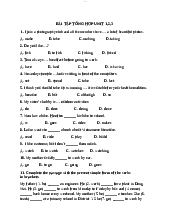






Preview text:
CHILDREN’S EDUCATION: Children’s education is expensive. In some countries, the
government pays some or all of the costs. Do the advantages outweigh its disadvantages?
There is no denying that the spending on children's education is exorbitant . Therefore in
some nations, the government invests partly or even fully subsidized. In my opinion, this
policy , albeit somewhat problematic, can confer positive benefits at large
There are several reasons why the government shouldn’t invest the budget in children's
education. The key rationale behind this thought is that the government can put a strain on
the state coffer to avoid budget deficits. Therefore, the government has to impose higher
taxes on residents around the countries including those who don’t have children. As a result,
this policy would place financial burden on taxpayers leading to social resentment
Despite the above argument, I firmly believe that this policy has a positive impact on society.
It must first be affordable education is a precursor to alleviating poverty in underprivileged
communities. This is because the poor children will stand a chance of landing decent jobs in
the future. In contrast, it can not be guaranteed that if they follow the footsteps of their
parents to work manual labor, they can escape from poverty. In addition to this, due to
expensive education, rearing a child is very difficult, which is one of the reasons behind the
delayed childbirth. Therefore if this burden is lifted , they will be less pressured to embark on
parenthood. In other words, it can contribute significantly to the development of society when
its workforce involves more young people.
In conclusion, while it is true to some extent that the spending on children's education has
some negative impacts on society. I believe would maintain that this policy brings about
greater benefits in breaking the shackle of poverty and decreasing the delayed birth Nâng cấp lập luận
Introduction: There is no denying that the spending on children's education is exorbitant.
Therefore in some nations, the government invests partly or even fully subsidized. In my
opinion, this policy, albeit somewhat problematic, can confer positive benefits at large
Feedback for Introduction:
Clear Position: The introduction effectively states a clear position by acknowledging the
high cost of children's education and the government's investment in it. It also hints at the
potential benefits of this policy, which is a good start. However, it could be strengthened by
more explicitly stating the advantages and disadvantages of the policy to provide a clearer framework for the argument.
Relevance: The introduction is relevant to the essay question as it addresses the topic of
government investment in children's education. It sets the stage for discussing the
advantages and disadvantages of this policy. To enhance relevance, it could briefly mention
the specific aspects of the policy that will be explored in the essay, such as its impact on poverty and the workforce.
Brief Overview: The introduction lacks a brief overview of the main points that will be
discussed in the essay. Including a sentence that outlines the key arguments for and against
government investment in children's education would provide a clearer roadmap for the
reader and enhance the introduction's effectiveness.
Improved Introduction: The significant expenditure on children's education is undeniable,
leading some governments to partially or fully subsidize it. While this policy presents both
advantages and disadvantages, I believe its benefits outweigh its drawbacks. This essay will
explore the positive impacts of government investment in children's education, such as
breaking the cycle of poverty and increasing the workforce, while also acknowledging the
potential drawbacks, including the strain on government finances and the impact on taxpayers.
Main Point 1: There are several reasons why the government shouldn’t invest the budget in
children's education. The key rationale behind this thought is that the government can put a
strain on the state coffer to avoid budget deficits. Therefore, the government has to impose
higher taxes on residents around the countries including those who don’t have children. As a
result, this policy would place financial burden on taxpayers leading to social resentment
Feedback for Main Point 1:
Argumentative Logic: The argument that government investment in children's education
could lead to budget deficits and increased taxes on non-parents is logically sound. It
effectively connects the financial implications of such a policy to potential social resentment
among taxpayers. However, the argument could be strengthened by discussing the long-
term benefits of education, such as increased economic productivity and social stability, to provide a more balanced view.
Overgeneralizations: The statement that the government will have to impose higher taxes
on all residents, including those without children, is an overgeneralization. It assumes a
direct and uniform impact without considering alternative funding mechanisms or the
potential for targeted subsidies or tax breaks for specific groups.
Relevance and Effectiveness of Supporting Ideas: The idea that increased taxes could
lead to social resentment is relevant and effectively supports the argument against
government investment in children's education. However, the argument would benefit from
more specific examples or scenarios where such resentment has occurred in the past to make the point more concrete.
Unclear or Ambiguous Expressions: The expression "the government can put a strain on
the state coffer to avoid budget deficits" is somewhat vague. Clarifying what specific
measures the government might take to avoid deficits, such as reducing other expenditures
or increasing revenue through other means, would improve clarity.
Unwarranted Assumptions: The argument assumes that the financial burden of education
will always lead to social resentment without considering the potential for public support for
education as a social investment. It also assumes that all taxpayers will be equally affected
by increased taxes, which may not be the case.
Overly Assertive Language: The definitive language used to describe the consequences of
government investment in education could be softened to acknowledge that while these are
potential outcomes, they are not inevitable. Phrases like "could lead to" or "might result in"
would provide a more balanced perspective.
Overall Evaluation: Insufficiently Developed or Lack Clarity
Suggestions for Improvement:
Detail Alternative Funding Mechanisms: Discuss alternative funding mechanisms that
could reduce the financial burden on taxpayers, such as private donations, corporate
sponsorships, or international aid.
Introduce Long-Term Benefits: Include a discussion on the long-term benefits of
education, such as increased economic productivity and social stability, to provide a more
balanced view of the policy's potential impacts.
Clarify Financial Implications: Specify how the government might manage budget deficits
or increase revenue to fund education without imposing higher taxes on all residents.
Balance the Argument: Acknowledge the potential for public support for education and the
benefits it can bring to society, which could mitigate the negative Task Response
Band Score for Task Response: 6
Answer All Parts of the Question:
Detailed explanation: The essay addresses both the advantages and disadvantages of
government subsidies for children's education. It acknowledges the strain on government
budgets and potential resentment from taxpayers while emphasizing the benefits such as
breaking the cycle of poverty and encouraging earlier parenthood.
How to improve: To enhance the score, ensure that each aspect of the prompt
("advantages outweigh disadvantages") is explicitly discussed and balanced in depth.
Provide more specific examples or statistics to support claims.
Present a Clear Position Throughout:
Detailed explanation: The essay maintains a clear stance that government subsidies,
despite some drawbacks, bring substantial benefits to society. The position is consistently
articulated through examples and arguments.
How to improve: Strengthen the coherence by linking each paragraph explicitly back to the
central argument. Consider addressing potential counterarguments to further solidify the stance.
Present, Extend, and Support Ideas:
Detailed explanation: Ideas are presented but could benefit from further development and
clarity. For instance, while poverty alleviation and workforce development are mentioned,
they could be expanded with more nuanced analysis or real-world examples.
How to improve: Extend ideas with specific examples, data, or hypothetical scenarios to
illustrate the practical implications and enhance the depth of analysis. Stay on Topic:
Detailed explanation: The essay mostly stays on topic by discussing the pros and cons of
government subsidies for children's education. However, some parts could be more tightly
connected to the main argument.
How to improve: Ensure each paragraph directly relates to the prompt. Avoid tangents that
do not directly contribute to discussing whether advantages outweigh disadvantages.
Overall, the essay demonstrates a good understanding of the prompt and effectively
presents arguments for both sides of the issue. To improve, focus on deeper analysis,
clearer organization, and ensuring every part of the prompt is thoroughly addressed with
well-supported arguments and examples. Coherence & Cohesion
Band Score for Coherence and Cohesion: 6
Organize Information Logically:
Detailed explanation: The essay demonstrates a basic level of organization. It begins with
an introduction that outlines the topic and the author's opinion. The body paragraphs discuss
reasons against government investment in education and reasons supporting it, though the
transitions between these ideas are somewhat abrupt. The conclusion attempts to
summarize the main points but lacks a clear restatement of the author's opinion.
How to improve: To enhance logical organization, consider structuring the essay more
clearly with distinct paragraphs for each main idea (e.g., separate paragraphs for arguments
against and for government investment). Ensure each paragraph has a clear topic sentence
and supporting details that logically connect to the thesis statement. Use transition words or
phrases to guide the reader smoothly through different sections of the essay. Use Paragraphs:
Detailed explanation: The essay uses paragraphs, but their structure and coherence can
be improved. Some paragraphs lack a clear main idea and may combine multiple thoughts.
For example, the paragraph discussing reasons against government investment could
benefit from separating different arguments into distinct paragraphs.
How to improve: Focus on each paragraph having a single, cohesive main idea that directly
supports the thesis. Start each paragraph with a clear topic sentence that previews what the
paragraph will discuss. Ensure that supporting sentences provide relevant details and
examples that strengthen the main idea. Use transitions between paragraphs to create a
smooth flow of ideas and avoid abrupt shifts in topic.
Use a Range of Cohesive Devices:
Detailed explanation: The essay attempts to use cohesive devices such as linking words
("therefore," "despite," "in addition to this") and pronouns ("this policy," "it"). However, their
usage is somewhat repetitive and does not always effectively connect ideas or clarify
relationships between sentences and paragraphs.
How to improve: Diversify the use of cohesive devices beyond basic transitions like
"therefore" and "in addition." Consider using a wider range of cohesive devices such as
pronouns (e.g., "these initiatives," "such measures"), conjunctions (e.g., "although,"
"moreover"), and adverbs (e.g., "consequently," "thus"). Ensure that each cohesive device is
used correctly and contextually to strengthen the coherence and flow of the essay.
Overall, while the essay demonstrates an understanding of coherence and cohesion
principles, there is room for improvement in organizing ideas more clearly, refining
paragraph structure, and diversifying the use of cohesive devices. Implementing these
suggestions can help elevate the essay to a higher band score by enhancing its clarity,
logical progression, and overall coherence. Lexical Resource
Band Score for Lexical Resource: 6
Use a Wide Range of Vocabulary:
Detailed explanation: The essay demonstrates a reasonable range of vocabulary. There
are instances where synonyms and varied expressions are used effectively, such as
"exorbitant" for expensive and "budget deficits" for financial problems. However, there are
also repetitions and instances where simpler vocabulary could have been replaced with
more sophisticated alternatives.
How to improve: To enhance lexical variety, consider using more precise vocabulary
throughout the essay. For example, instead of repeating "government," use synonyms like
"authorities" or "state entities." Additionally, aim for more nuanced phrases to express
complex ideas, such as "economic strain" instead of "put a strain on the state coffer."
Use Vocabulary Precisely:
Detailed explanation: While the essay generally conveys ideas clearly, there are some
instances where vocabulary could be more precise. For instance, phrases like "follow the
footsteps" could be replaced with "emulate" or "imitate," which would provide a clearer and
more refined expression of the idea.
How to improve: Pay closer attention to the context in which words are used. Consider
whether there are more specific terms that could better convey your intended meaning. For
example, instead of "a chance of landing decent jobs," consider "opportunities for gainful employment." Use Correct Spelling:
Detailed explanation: The essay demonstrates adequate spelling accuracy with a few
minor errors (e.g., "coffer" instead of "coffers"). However, overall, spelling does not
significantly detract from the clarity of the writing.
How to improve: Continue to review spelling carefully, especially for words that are critical
to the coherence of your argument. Utilize spell-check tools and proofread thoroughly before submitting.
In summary, while the essay shows a competent use of vocabulary and generally maintains
good spelling accuracy, there is room for improvement in enhancing lexical variety and
precision. Focus on utilizing synonyms effectively and refining vocabulary choices to better
articulate complex ideas. With continued attention to these areas, your writing will further
strengthen its clarity and impact.
Grammatical Range & Accuracy
Band Score for Grammatical Range and Accuracy: 6
Use a Wide Range of Structures:
Detailed explanation: The essay demonstrates a reasonable range of sentence structures,
including complex sentences ("In my opinion, this policy, albeit somewhat problematic, can
confer positive benefits at large") and conditional sentences ("If this burden is lifted, they will
be less pressured to embark on parenthood"). However, there is room for improvement in
varying sentence structures further to enhance coherence and readability.
How to improve: To enhance variety, consider incorporating more compound-complex
sentences and varying the use of introductory clauses and phrases. For instance, instead of
starting most sentences with "therefore" or "despite," try using introductory adverbial phrases
like "Consequently," "Moreover," or "On the contrary."
Use Grammar and Punctuation Accurately:
Detailed explanation: The essay exhibits a mix of grammatical accuracy. There are
instances of incorrect verb tense agreement ("it can not be guaranteed"), awkward phrasing
("due to expensive education, rearing a child is very difficult"), and punctuation errors
(missing commas in compound sentences). However, the overall communication is clear despite these issues.
How to improve: Focus on verb tense consistency throughout the essay. Revise awkward
phrasing to improve clarity and coherence. Pay attention to comma usage in compound
sentences to separate independent clauses properly. For example, "due to the expense of
education, raising a child becomes very difficult" could enhance clarity and grammatical accuracy.
Overall, while the essay effectively presents arguments and ideas, further attention to
sentence structure variety and grammatical accuracy will elevate the quality of expression and coherence. Bài chữa tham khảo
There is no denying that the expenditure on children's education is substantial. Therefore, in
some nations, the government partially or even fully subsidizes this cost. In my opinion, this
policy, although somewhat problematic, can yield significant benefits overall.
There are several reasons why some argue that the government should not allocate the
budget to children's education. The main rationale behind this argument is that it could strain
the state's finances and potentially lead to budget deficits. Consequently, the government
might need to impose higher taxes on residents across the country, including those without
children. This, in turn, could impose a financial burden on taxpayers, creating social discontent.
Despite these concerns, I maintain that this policy brings about greater benefits. Affordable
education is a precursor to alleviating poverty in underprivileged communities. It provides
opportunities for children from poorer backgrounds to secure better jobs in the future, which
might not be possible if they were to follow their parents into manual labor due to the high
cost of education. Moreover, the financial challenge of raising children is one reason for
delayed childbirth. Therefore, easing this burden could reduce the pressures that discourage
parenthood. Additionally, involving more young people in the workforce through education
can significantly contribute to societal development.
In conclusion, while it is true that spending on children's education may have some negative
impacts on society, I believe that this policy brings about greater benefits in alleviating
poverty and reducing delayed childbirth.




